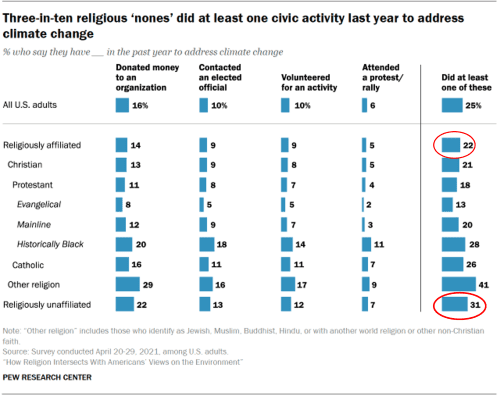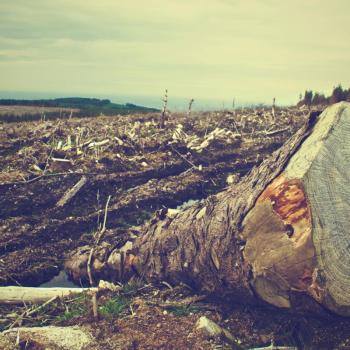Are you wanting to help your church connect with God’s Creation in a way that builds community and deepens spiritual engagement? Try the “Who Is My Neighbor in Creation” Mapping Exercise!

A 2022 study by the Pew Research Center found that 92% of highly religious Americans say God gave humans a duty to protect and care for the Earth. This is great news!
But this belief is not translating into action to protect Creation.
Only 44% of those highly religious Americans did at least four things in their daily lives to help protect the environment (such as reducing food waste or eating less meat).
The Pew study also found that religiously affiliated Americans are less likely to be involved in activities to address climate change than their non-religious counterparts. Only 22% did at least one civic activity in the last year to address climate change, compared with 31% of those who are religiously unaffiliated.

So how can we help people of faith put their faith into action for God’s Creation?
To help answer this question, I developed the “Who is My Neighbor in Creation?” Mapping Exercise in my book Creation-Crisis Preaching: Ecology, Theology, and the Pulpit. The tool is designed to help a pastor and congregation develop thought-provoking queries and actionable ideas to explore the ecological, social, cultural, and political landscape in which their congregation is situated.
Establishing a biblical foundation for Creation-Care: The Parable of the Good Samaritan, Luke 10:25-37
I selected Luke 10:25-37 as the foundation for this exercise. The passage features a lawyer’s inquiry to Jesus, leading to the well-known parable of “The Good Samaritan.”
In the story, the lawyer asks about the path to inheriting eternal life, to which Jesus responds with a query. “What does the law say? How do you interpret it?”
The lawyer then quotes the Torah, stating: “Love the Lord your God with all your heart, soul, strength, and mind; and love your neighbor as yourself.” Jesus affirms this.
However, the lawyer follows up with another question: “Who exactly is my neighbor?”
In response, Jesus narrates a parable involving a Samaritan who tends to an injured man after two others had disregarded him. Subsequently, Jesus poses the question, “Which of these three individuals, in your opinion, acted as a neighbor to the man who fell victim to the robbers?”
The lawyer answers, “The one who showed him compassion.”
The passage concludes with Jesus directing the lawyer to “Go and do likewise.”
The lawyer’s question can be reframed as, “Who deserves my ethical consideration? Who meets the criteria? And who can I reasonably and justifiably exclude?”
Jesus’s response shifts the question. He asks, “To whom will you choose to show empathy?”
What defines “neighborness”?
As I explain in my book, Creation-Crisis Preaching: “It is not the qualifications of the one who suffers that determine who should be considered ‘neighbor.’ It is the one who chooses to care who makes herself or himself a neighbor. In other words, ‘neighborness’ is not initiated by the one in need of care. It is determined by the one choosing to act in a caring way toward another” (63).
In essence, being a neighbor is determined not by the recipient of kindness but by the giver. From the Samaritan’s perspective, the sole requirement for being a neighbor was the suffering and distress of the wounded man, dissolving all other boundaries, barriers, hierarchies, and divisions.

The Parable of the Good Samaritan – applied to our neighbors in Creation
As we look around at the ongoing Creation-crisis, the parable of the Good Samaritan carries profound implications for grappling with ethical responsibilities within the natural world and matters of environmental justice.
The parable prompts questions that Christians must ask as they strive to convey the message of Jesus within their unique environmental and social contexts.
- Do animals, mountains, and ecosystems fall within the scope of our neighbors?
- How far down the food chain and how broadly into the natural world should our concern extend?
- In what ways does the intricate web of the water cycle, food chain, air currents, and local/global economic systems impact the way we minister in our contexts?
I make the case that we must think more broadly about the concept of “neighbor” to include our Earth-kin. Our neighbors in Creation, in a sense, lie beaten and bleeding on the side of the road by “robbers” who have attacked and ravaged all aspects of Creation.
Who are the Earth-kin neighbors near your church?
In your own congregation, you can ask:
- Who within our ecological vicinity requires our consideration and the kind of compassionate care akin to that of the caring Samaritan?
- In what manner are individuals, flora, fauna, the land, and the atmosphere suffering as a result of human actions right in our own local community?
- How can our congregation address these issues by providing for healing, care, and generosity, much like the Samaritan in the parable?
To help explore these questions, I developed the mapping exercise, “Who Is My Neighbor in Creation.”
The tool consists of a series of activities that enable participants to immerse themselves in their congregation’s specific ecological setting. At the same time, it encourages a broader perspective on ecological concerns within the context of larger justice issues.
The activities, along with their accompanying questions, are structured to foster an interconnected approach, allowing participants to consider the ecological, social, cultural, and political dimensions of a particular congregation’s location, thus enhancing the contextualization of their ministry. This tool can assist pastors in conveying these insights through preaching, worship, or teaching within their faith community.
Who Is My Neighbor in Creation? Mapping Exercise
For the mapping exercise, I suggest that you pick six options from numbers 1 – 12. Then complete number 13 for your project. I encourage you to do this work in collaboration with a group of parishioners if possible so that you can incorporate more voices and perspectives. This activity can be done with children, youth, and intergenerational groups. Here are the options (found on pages 73-75 in Creation-Crisis Preaching). You can also download this as a PDF here.
1. Walk.
Walk the grounds around the church building. Consider your surroundings, which include the land, the plants near you, the air you are breathing, and other living creatures perceptible to your senses. Who are your biotic neighbors? Also consider the houses, buildings, businesses, factories, and other human-made “neighbors.” Reflect on the interactions that are occurring between you and these multi-faceted surroundings. Are they harmful? Beneficial? Neutral?
2. Sit.
Choose a location where you can sit and quietly observe and reflect on the interactions that are occurring between you and your multi-faceted surroundings. Allow all of your senses to be engaged as you listen, sniff, and feel the world around you. Where do you perceive harm or pain? What interrelations are beneficial? How do your natural surroundings affect your physical or spiritual existence? Your emotions? Your values?
3. Look at a topographical map where the congregation is located.
Google Maps, Google Earth, or other online mapping services are free and can reveal a bird’s eye view of your setting. Notice the local waterways, landscape features (mountains, desert, beach, green spaces, etc.). How are they disrupted, connected to, or otherwise intersecting with human civilization?
4. Look at a map that shows the location of major businesses, industries, landfills, waste processing, etc.
Do some research of the basic demographics of the area (census data, income data, sociological data). In what ways do the major “players” interact and have an impact on each other and the biotic community?
5. Talk with members of your congregation.
Ask them who their neighbors are — in the expanded ecological sense — and who has been beaten and lies along side of the road. Who are “the least of these” (Matthew 25:40) in Creation in need of attention and care?
6. Talk with local clergy.
Ask about the history of “neighbor-relations” in the community. What stories do they tell about neighbors helping each other (or not)? Do any of them have shared interest in environmental issues so that you may collaborate on local Creation-care and advocacy?
7. Talk with community members.
Listen to their stories about environmental issues that are part of the community’s history. Were there any grassroots efforts to clean up blighted areas? Protest pollution? Confront toxic dumping? What was successful? What work remains to be done?
8. Talk with local health care workers.
Interview doctors and nurses to find out what the key public health issues are in the community. There are often environmental connections to health concerns. Asthma, cancer, and depression, for example, are all exacerbated by deleterious environmental conditions such as air pollution, chemical waste, waste incineration, etc.
9. Meet with local chapters of environmental groups.
Seek out local meetings of groups such as Sierra Club, Clean Air Council, Interfaith Power and Light and grassroots activists to find out what environmental issues are facing your community. Ask how local houses of worship can be helpful to their work.
10. Talk with local naturalists, master gardeners, those who fish, hunters, farmers, beekeepers, or others whose work involves the natural elements.
Ask what changes they have observed in animal, plant, insect, fish, or other biotic communities in the last few decades. What would they like to see happen in terms of protecting or sustaining the health of the local ecosystems?
11. Search for clean-energy businesses in your community.
Look for businesses such as wind farms, solar farms, geothermal companies, etc. Inquire as to how they see their work in relation to the community and the planet.
12. Meet with your elected officials.
Ask them who they consider “the least of these,” or those most vulnerable among their constituents. What are their main environmental concerns regarding their watersheds, land, forests, and biotic communities within their territories? What legislation or policies have they supported or opposed for environmental protection?
13. Create a “map” of your findings.
This can take the form of an actual map with key features noted, a hand-drawn representation, a collage of photos or images, a video, PowerPoint, or some other kind of visual display of the “neighbors” surrounding your congregation.

You can complete this project in a setting such as a day-long retreat or in a series of activities spread out over several weeks. As your group works through the activities, share insights or “a ha” moments that arise for you along the way.
You can then present your “Who is My Neighbor In Creation” map at an educational forum, incorporate it into a sermon, or design a worship service around the themes from your mapping project.
Living out our faith
The “Who Is My Neighbor in Creation” Mapping Exercise can educate and empower your congregation to cultivate a Good Samaritan-like ethic of care for your local Earth-kin. In this way, they can live out their faith in Jesus’s teaching by extending compassion to their neighbors in both the human and environmental community.
Read also:
10 Principles for Environmental Preaching: How to Craft Eco-Sermons
How to Preach a Sermon about Climate Change and Your Congregation
ECO-WEDDING LITURGY: Ideas for a Creation-Centered Wedding

The Rev. Dr. Leah D. Schade is the Associate Professor of Preaching and Worship at Lexington Theological Seminary in Kentucky and ordained in the ELCA. Dr. Schade does not speak for LTS or the ELCA; her opinions are her own. She is the author of Preaching in the Purple Zone: Ministry in the Red-Blue Divide (Rowman & Littlefield, 2019) and Creation-Crisis Preaching: Ecology, Theology, and the Pulpit (Chalice Press, 2015). She is the co-editor of Rooted and Rising: Voices of Courage in a Time of Climate Crisis (Rowman & Littlefield, 2019). Her newest book is Introduction to Preaching: Scripture, Theology, and Sermon Preparation, co-authored with Jerry L. Sumney and Emily Askew (Rowman & Littlefield, 2023).













